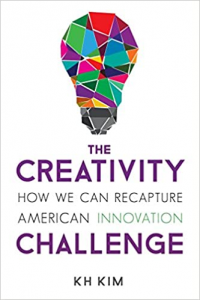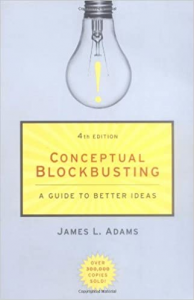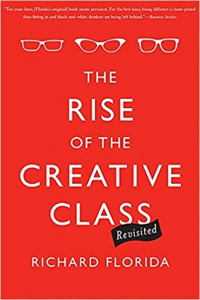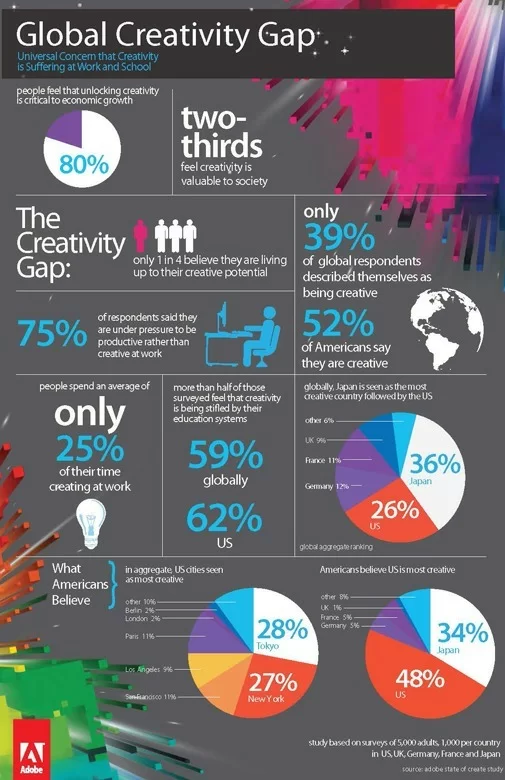We hope you’ve seen that there is intentionality [and evolution!] in our philosophies. Here are just a few resources we have found informative of our aims around creativity and expression:
(You can revisit the landing page here.)
Talks:
| Richard Florida – Why Creativity is the New Economy
This is “The Creative Age” – where creativity is the main means to economic and social prosperity. |
Sir Ken Robinson: Do Schools Kill Creativity?
Yes. And summer camp re-creates it. Here’s another, similar talk by Seth Godin. |
Malcolm McLaren: Authentic Creativity vs. Karaoke Culture
Cultivate authentic expression in a world of imprinting and copying. |
| Marily Oppezzo: Want to be more creative? Go for a walk
Activity sparks creativity. |
Artūrs Miksons: The benefits of expressing your emotions (constructively)
People need people – to feel and to express and to connect. |
Derek Sivers: Weird or Just Different?
People see the world in different ways. So can you. |
Books:
| The Creativity Challenge: How We Can Recapture American Innovation
|
Free to Learn:
Message: Developmental psychologist Peter Gray argues that our children, if free to pursue their own interests through play, will not only learn all they need to know, but will do so with energy and passion. |
Conceptual Blockbusting: A Guide to Better Ideas
|
The Rise of the Creative Class (Revisited)
Video: Richard Florida – Why Creativity is the New Economy Message: “Increasingly, Florida observes, this Creative Class determines how workplaces are organized, what companies prosper or go bankrupt, and which cities thrive.” |
Websites
What Is Creativity?
- Creativity & Expression – For starters… what are they?
- What is creativity? The ultimate guide to understanding today’s most important ability. – A look into the emerging science, models, and narratives around creativity and its importance in the modern day.
The Creativity Crisis
- America’s Looming Creativity Crisis – A Harvard Business Review article on creativity in the modern world
- How to Combat America’s Creativity Crisis – Some traits associated with creativity and how to foster them
- The Global Creativity Gap: A new study by Adobe – Adobe did a study of 5,000 adults from different countries to highlight some workplace and education related creativity trends.
Teaching Creativity
- Reclaiming Your Creative Self – Acknowledging the decline in creativity personally and in culture, the question then goes to why that is and how to reignite that attribute.
- Creative Teaching and Teaching Creativity: How to Foster Creativity in the Classroom – A list of offerings for educators – informed by the American Psychology Association.
- Creativity is the New Economy – An exploration of Richard Florida’s concept of the Creative Age, the basis behind it and the implications from it.
- How Does Environment Influence Creative Thinking? – Creating an intentionally creative environment
- You’re 96 Percent Less Creative Than You Were as a Child. Here’s How to Reverse That – An overview of NASA’s longitudinal study on creativity over time and how to reconnect to child-like creativity.
Interesting Statistics
The Creative Age…
- “Indeed, the United States has now entered what I call the Creative Age.” – Richard Florida PhD, urban studies theorist focusing on social and economic theory.
- In tests of more than 270,000 people, Educational Psychologist KH Kim has found that Americans’ creativity rose from 1966 to 1990, but began significantly declining after then. (KH Kim 2011)
- Currently, 30% of the workforce and 50% of all United States income comes from “the creative sector.”
- Some have cited that the ‘success’ of the United States in innovation and business during that time stemmed from its openness to new ideas, which has allowed it to “mobilize and harness the creative energies of its people.” This was spurred by government programs, war, social movements, immigration, and more for decades.
- Economically, “Today, the creative sector of the U.S. economy, broadly defined, employs more than 30% of the workforce (more than all of manufacturing) and accounts for nearly half of all wage and salary income (some $2 trillion)—almost as much as the manufacturing and service sectors together.”
- In tests of more than 270,000 Educational Psychologist KH Kim has found that Americans’ creativity rose from 1966 to 1990, but began significantly declining after then.
Creativity in the Workplace…
- Creativity is or is related to nine of the top 10 skills that global executives say is essential for 2020 and beyond. (World Economic Forum)
- 94 percent of hiring managers say it is important to consider creativity when hiring a job candidate. (Adobe, Hiring for the Future (2014))
- Creative problem-solving sessions with groups that have even a minimal amount of training in creativity tools and principles generated 350 percent as many ideas than groups without training—and these ideas were 415 percent more original. (Puccio, et al)
- CEOs say creativity is the No. 1 factor for future success. (IBM)
- Recruiters rank creative problem solving as the second-most difficult skill to find among job applicants. (Bloomberg Businessweek)
- In a study of 1,000 full-time, salaried College graduates…
Fostering Creativity:
- Trying New Things Makes You More Creative – There is a major link between the two, thought to stem from the psychological plasticity associated with flexibility and trying things. The researchers write: “the drive for exploration, in its many forms, may be the single most important personal factor predicting creative achievement.”
- Daydreaming Is Surprisingly Good For Your Brain – These moments provide a sort of mental incubation period that can enhance creative thinking, long-term planning, and self awareness. (Sio 2013)
- Sleep is beneficial for creative thought – A quick nap here and there greatly enhances individuals’ ability to problem solve.
- Conformity kills creativity – Pressures of conformity elicit types of motivation that are not compatible with the creative process and individuals who are highly susceptible to these pressures tend to hold certain personality traits that are detrimental to creative thinking.
- Creative people live longer – Due to their openness, creative minds tend to live longer, and may even get more creative with age. A big factor in this is relationship to stress. (Byron 2010)
- Positivity enhances creativity – Happiness and motivation actually bring out the highest levels of creative activity. Sadness had a neutral effect, while anxiety and fear brought about the lowest levels of creativity.
- A diverse social network enhances creativity – Having a broad mix of friends and influences has been shown to improve creativity. Mostly benefiting specific types of knowledge and having a domain-specific effect on creativity, being part of a multicultural social circle is best for idea flow.
- Creative people get messy – According to this study, messy workspaces encourage creative thinking, while a clean space is advised for sound decision making. Inspiring idea generation in an environment that breaks free of tradition, cluttered spaces allow the brain to concentrate on the bigger picture.
- Everyday creative activity is crucial for creative behaviour. – Exercising the creative muscles in your brain is known to boost creative accomplishment.
- Listening to happy music stimulates divergent thinking – In a study on creativity, people listening to upbeat classic music performed better on creative tasks overall the those listening to no music.
- Walking and Exercise Increase Creative Potential – Participants were asked to complete creative tasks on a treadmill and/or sitting. Over 81 percent of people were more creative when they were walking (on a treadmill or outside) than when they were seated.
- Stress is bad for creativity – According to this study, subjects in a relaxed examination environment monumentally out-performed subjects subjected to a stressful examination process. (Byron 2010)
More: Compendium of creativity, collaboration, and innovation stats and research
Quotes
“The desire to create is one of the deepest yearnings of the human soul.”
― Dieter F. Uchtdorf
“Everything you can imagine is real.”
― Pablo Picasso
“You can’t use up creativity. The more you use the more you have.”
― Maya Angelou
“Creativity is intelligence having fun.”
― Albert Einstein
“To practice any art, no matter how well or badly, is a way to make your soul grow. So do it.”
― Kurt Vonnegut
“Creativity is inventing, experimenting, growing, taking risks, breaking rules, making mistakes, and having fun.”
― Mary Lou Cook
“Creativity involves breaking out of expected patterns in order to look at things in a different way.”
― Edward de Bono
“A bird doesn’t sing because it has an answer. It sings because it has a song.”
― Lou Holtz
“Who were you before the world told you what you were not?”
― Bryant McGill, Simple Reminders: Inspiration for Living Your Best Life
“No man has the right to dictate what other men should perceive, create or produce, but all should be encouraged to reveal themselves, their perceptions and emotions, and to build confidence in the creative spirit.”
― Ansel Adams
“I don’t believe in fashion. I believe in costume. Life is too short to be same person every day.”
― Stephanie Perkins, Lola and the Boy Next Door
“Follow your inner moonlight; don’t hide the madness.”
― Allen Ginsberg
“I want freedom for the full expression of my personality.”
― Mahatma Gandhi, The Essential Gandhi: An Anthology of His Writings on His Life, Work, and Ideas
“Human resources are like natural resources; they’re often buried deep. You have to go looking for them, they’re not just lying around on the surface. You have to create the circumstances where they show themselves.”
― Ken Robinson
“The Element is about discovering your self, and you can’t do this if you’re trapped in a compulsion to conform. You can’t be yourself in a swarm.”
― Ken Robinson, The Element: How Finding Your Passion Changes Everything
“If you celebrate your differentness, the world will, too. It believes exactly what you tell it—through the words you use to describe yourself, the actions you take to care for yourself, and the choices you make to express yourself.”
― Victoria Moran, Lit From Within: Tending Your Soul For Lifelong Beauty
Still here? Okay… Scientific Journals & Meta-analyses
Feist, G. J. (1998). A Meta-Analysis of Personality in Scientific and Artistic Creativity. Personality and Social Psychology Review, 2(4), 290–309. https://doi.org/10.1207/s15327957pspr0204_5
This meta-analysis looked at tests results of the Big 5 and compared distinguishing personality factors among scientific and artistic vocations. In general, creative people are more open to new experiences, less conventional and less conscientious, more self-confident, self-accepting, driven, ambitious, dominant, hostile, and impulsive. Out of these, the largest effect sizes were on openness, conscientiousness, self-acceptance, hostility, and impulsivity.
Byron, Kristin,Khazanchi, Shalini,Nazarian, Deborah Byron, K., Khazanchi, S., & Nazarian, D. (2010). The relationship between stressors and creativity: A meta-analysis examining competing theoretical models. Journal of Applied Psychology, 95(1), 201–212. https://doi.org/10.1037/a0017868
Combining results of 76 studies to study the relationship of stress and creativity, researchers found that low evaluative contexts increased creative performance over control conditions, whereas highly evaluative contexts decreased creative performance. Among this, uncontrollability always decreased creative performance.
Rose, Laura Hall, Lin, Hsin-tai. (1984) A Meta‐Analysis of Long‐Term Creativity Training Programs. Journal of Creative Behavior, 18 (1), 11-22. https://doi.org/10.1002/j.2162-6057.1984.tb00985.x
In a metastudy of creativity-focused instructional practices, it is shown significantly that training, practice, and encouragement in using creative thinking skills can increase the degree of creativity manifested by individuals.
Hsen-Hsing Ma (2009) The Effect Size of Variables Associated With Creativity: A Meta-Analysis, Creativity Research Journal, 21:1, 30-42, DOI: 10.1080/10400410802633400
Related to affecting creativity, this paper explored the effects of different variables on different measures of creativity across a variety of studies. It notably showed that
(a) the mean effect sizes associated with problem-solving creativity and verbal creativity were significantly larger than those associated with emotional creativity and nonverbal creativity,
(b) variables having a large mean effect size were prestige of honors/awards, working circumstances favorable for creativity, defining problem, and retrieving knowledge
By Gajda, Aleksandra,Karwowski, Maciej,Beghetto, Ronald A. (2017) Creativity and academic achievement: A meta-analysis Journal of Educational Psychology, Vol 109(2), 269-299
Of 120 studies on the relationship of creativity and academic achievement, there was a strong correlation between higher creativity scores and higher academic achievement.
Kim, KH (2011) The Creativity Crisis: The Decrease in Creative Thinking Scores on the Torrance Tests of Creative Thinking, Creativity Research Journal, 23:4, 285-295, DOI: 10.1080/10400419.2011.627805 – According to 6 Torrence Tests over 6 different year spans, creative thinking scores remained static or decreased starting at 6th grades, and since 1990 creativity scores have significantly decreased (even amidst rising IQ scores)
Sio, U.N., Monaghan, P. & Ormerod, T. Sleep on it, but only if it is difficult: Effects of sleep on problem solving. Mem Cogn 41, 159–166 (2013). https://doi.org/10.3758/s13421-012-0256-7
Tasked with various-difficulty problems, scientists studied the outcome of the problem solving after no time, awake time, and sleeping time. “The sleep group solved a greater number of difficult problems than did the other groups, but no difference was found for easy problems. [They] concluded that sleep facilitates problem solving, most likely via spreading activation, but this has its primary effect for harder problems.”








